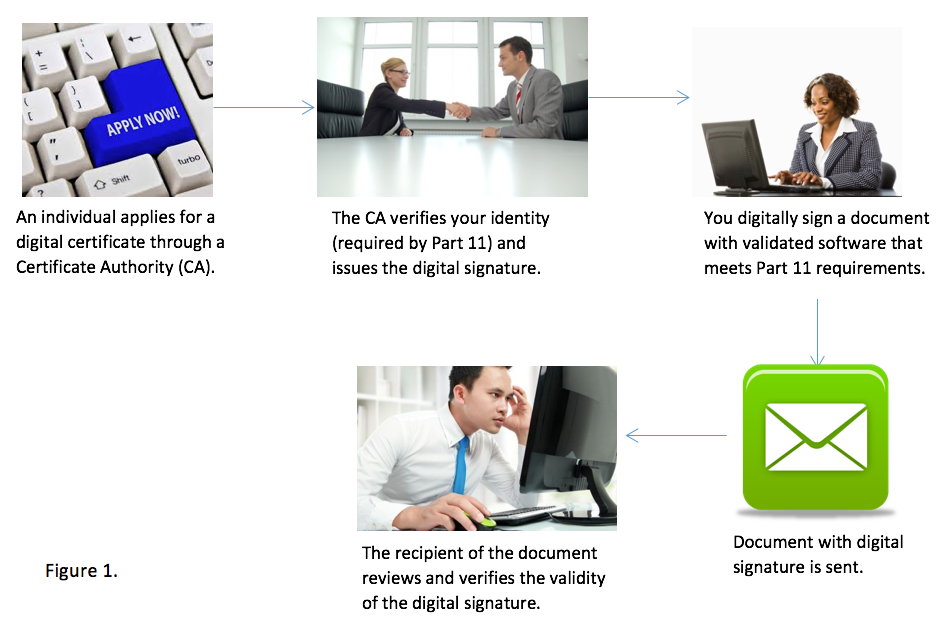Simplifying eSignatures
With the healthcare industry’s transition from paper to digital, verification is changing beyond that of a signature in ink. Electronic signatures are a new medium in clinical trials that the industry is now turning to in this transition to digital.
The future is here, it is digital, and nothing seems to be exempt – and that includes clinical trials. As the healthcare industry has transitioned from paper to computers and tablets, verification has changed dramatically as well. With more files going digital, the industry is discovering how to make signatures possible in the new medium.
What is an eSignature?
An eSignature can be any symbol, series of symbols or graphic authorized by an individual to be the legally binding equivalent to the individual’s handwritten signature. For example, a valid eSignature could be a checkbox seen after a ‘terms and conditions’ section. The Electronics Signatures in Global and National Commerce Act (ESIGN), which was enacted June 30, 2000, makes such a checkbox a valid signature. Other examples of eSignatures you may see in commerce include records signed with a digital signature in software such as Adobe Acrobat, Microsoft Office Products or email. You may also be asked to sign a contract via an electronic pen pad.
Benefits of eSignatures
In clinical trials, and indeed across many industries, eSignatures have grown in popularity as a more efficient and cost effective option. Documents that can be e-signed between companies and people move much faster than hard copies that must be sent through the mail. eSignatures eliminate the need to sign a hard copy and then scan it in or fax it to the respective party by removing the need for additional steps and electronic equipment to move the signature along.
From a clinical trial-specific perspective, eSignatures have sped the process as well. It’s a huge benefit to be able to sign documents in a data capture system and have the signature immediately passed to the team. Once information is captured, the investigator can log in and e-sign the data, immediately approving it to be analyzed – say to determine if the drug is safe for patients – moving the process along at a much quicker rate. By using eSignatures on computer systems validation documentation, Rho has reduced documentation time by approximately 60%, and reduced costs by more than $75,000 per year.
eSignatures have also made it easier for companies to reduce their environmental footprint – with digital files instead of hard copies, significantly less paper can be used on a day-to-day basis. At Rho, the switch to eSignatures allowed us to reduce our environmental footprint by 33%.
Digital signatures vs. eSignatures
Where an eSignature can be any graphic that replaces a handwritten signature, such as a checkbox, a digital signature is a type of eSignature that is based on Public Key Infrastructure (PKI). This helps guarantee signer authenticity, data integrity and non-repudiation of signed documents. PKI includes two keys, a private key used only by the signer and a public key used to validate the signature, for every signed transaction. This allows the individual receiving the digitally signed document to validate that the person signing is who they say they are. A certificate authority (CA) identifies a person and verifies their identity prior to providing the signer with a digital signature. This process is depicted in Fig. 1.

Digital signature use in clinical investigations
Digital signatures are becoming more widely used in clinical research. In fact, the U.S. Food and Drug Administration has created FDA Forms (e.g. 1571, 1572, 356h) that include a digital signature on the form, and has stated that [they] “cannot hold digital signatures to a higher standard than paper signatures.”
This is great news for the adoption of digital signatures in clinical research. So long as the digital signatures meet Part 11 requirements, they can be used in clinical research. To meet Part 11 requirements, digital signatures need a few additional components beyond the public and private identification keys. To use digital signatures in research, you must ensure the software used for signing has audit trails and displays the printed name, date/time, and the meaning of the signature.
Best practices for using eSignatures
At Rho, we began using digital signatures eight years ago and eSignatures 10 years ago, and have set forth several best practices for when and how to use both signatures.
First, all software and devices used to digitally sign electronic records at Rho go through a rigorous validation process. Second, a robust training program is key. All Rho employees must understand how to use and verify digital signatures, as well as look for signs of fraud and know what to do if something looks off. Keeping an eye out for potential scams is also important in protecting the confidential information gathered and signed-off on in clinical trials. Rho employees are also trained on how eSignatures are used in commerce to ensure that the legality of a checkbox is understood, whether part of a trial or not.
Any electronic record or document required by predicate rules may be signed by digital signature. Examples of these include, but are not limited to, protocols, monitoring reports, SOPs, validation documentation, and training records. With training to understand how to review and apply digital and eSignatures, the documentation phase of clinical trials can be sped enormously.
There are tremendous benefits to switching from signing hard copy documents with wet ink signatures to eSignatures and digital signatures that will save sponsors time and money by getting products to market quicker and easier. If making the switch, make sure your team is properly trained and using validated software to protect the clinical trial process.
Kevyn Matijevich is Validation Specialist at Rho.
How Digital Technology and Remote Assessment Strategies Can Aid Clinical Trial Research
July 24th 2020While there's been hopeful news on treatments and vaccines, sponsors should plan to discuss necessary strategies and contingencies at the outset of new studies or re-opening of halted studies during the COVID-19 pandemic.